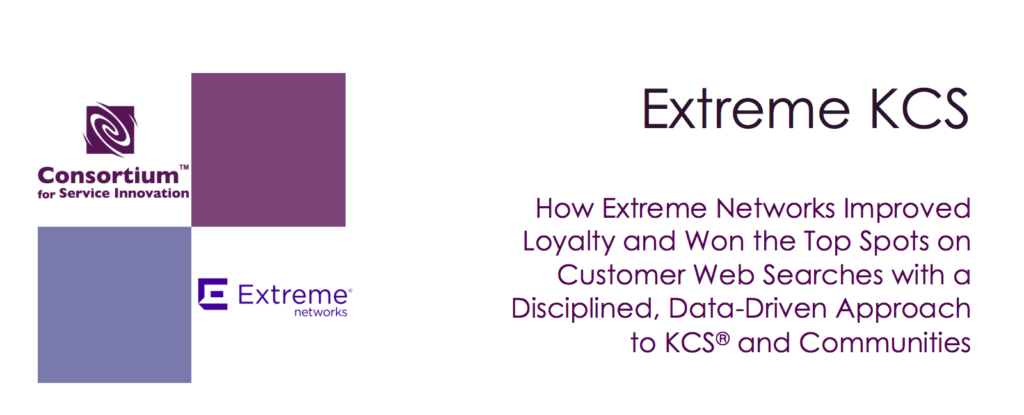The Consortium for Service Innovation just published a new KCS case study we wrote highlighting the success of Extreme Networks in implementing KM, self-service, and communities. I encourage you to read it—there are good lessons for any KCS practitioner.
In this blog, I’d like to complement the case study with my perspective as their consultant. A good consultant’s favorite client isn’t the one that pays you the most; it’s the client that follows your advice and successfully executes. Extreme Networks was that client. Here’s what I observed in working with them.
- Active, effective senior leadership. Executive sponsors need to do more than just sign off on the program. They need to be articulate advocates for a vision, and how KCS fits into that vision. During the first ten minutes of our design workshop, the VP laid out exactly why the program was important to him, to Extreme, and to customers. The message was clear, concise, and compelling. I noted his points on a whiteboard, and we referred to them again and again through the week. Ten minutes in to our engagement, I knew we were set up for success.
- Starting with the end in mind. Extreme is a large global organization that had just completed a significant acquisition at the time of the roll-out. There was no way to flip a switch and make communities, self-service, and KM happen overnight. But they laid out a plan to get there over months and years, and implemented one step at a time. As my colleague Francoise Tourniaire likes to say, “Dream big, but implement small.”
- Embracing best practice. It’s human nature to want to put your own stamp on things, but when there’s a well-proven path to success like KCS, it’s generally good to do things by the book whenever possible. Extreme was punctilious in following the guidance of KCS documentation—not blindly, but precisely, and within their context. The Extreme KCS program leadership quotes Consortium materials back to me every time we make contact! I love it.
- Driving decisions with data. Extreme invested significant staff time to generating the right metrics and performance indicators to assess and manage the program as it moved through its phases. When the data validated their actions, they could proceed with confidence. When the data was showing that things weren’t going as expected, they took action. They never just “winged it.”
- A relentless focus on execution. It’s easy to get complacent and reactive in any job. The program has launched, there are new initiatives—it’s easy to take your eye off the ball. The Extreme program leadership was, in my view, unremittingly proactive about the program. They continually ask, where are we relative to our plan? What could go wrong? Are there any worrying signs? If things are going well, what new thing should we start measuring and improving? There was no resting on success.
I often tell clients that I hope to someday write their case study. I’m glad my hope was fulfilled with Extreme!
Download the KCS case study.

Excellent read, David…thanks to you and Extreme Networks for sharing! Would you be able to elaborate on “…investing in creating offline processing to get the rest of the data required.”? Also, could you comment on the tool(s) used for their customer-tuned portal searches?
Hey Sue and David…I can take this one.
The comment on “…investing in creating offline processing to get the rest of the data required” really stems from our inability to generate all the necessary KCS reports the Practices Guide calls out in our CRM. Especially early on in the project. So, I’m sure like many before us, we had to dedicate some time and brain power to building these very useful reports outside of the CRM (I should note that we use KCS certified SFDC Service Cloud for CM & KM and are very happy with it). “Offline processing” of data has it’s own challenges as you can imagine. For example, it took us 9 months to generate a proper RADAR Chart, but the team prevailed and these incredibly valuable reports drove us forward.
It’s great to see more and more “by the book” KCS reports being built in to SFDC. That’s a great trend that I for one would like to see continue. I’m also now a big believer that your KCS team must also have a dedicated data analyst. Our data analyst (Mr. Kieran Wright) was an absolute rock stars and really helped drive the project forward across each phase of the adoption and beyond.
The “customer-tuned portal searches” is a call out to Extreme’s investment in Coveo Unified Search (a KCS aligned tool). We found that we could drive adoption to our self-service and peer-to-peer service channels by leveraging Google. Once we got them there, we wanted to offer an improved, personalized service by offering Unified Search with Coveo. This helped encourage users to log-in, which improved our ability to asses “% of users that start their self-service experience on the web and what % were successful”. So far so good!
Thanks for the kind words Sue and taking the time to read the Extreme KCS case study.
Thank you, Ryan! Glad to learn of your successful KCS implementation. We too had to go outside of our CRM tool to generate meaningful reports.